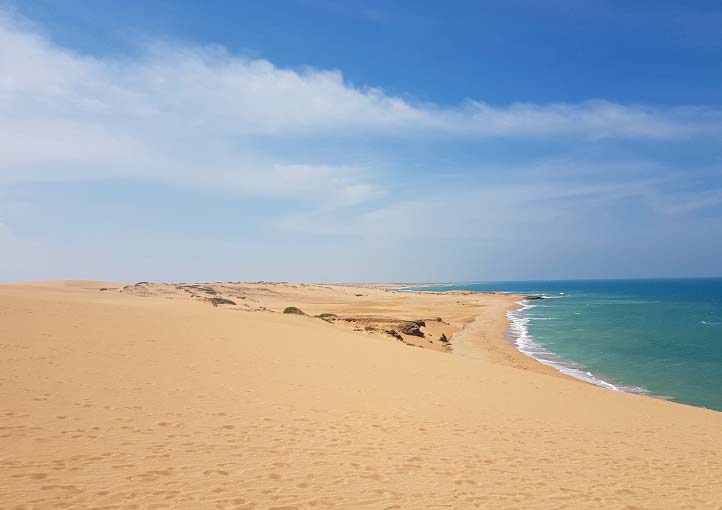Dear readers
My name is Frank and I run a tour operator in Bogota, specializing in custom-made and Colombia luxury travel.
At the end of this guide you will find a list of many other helpful travel guides for Colombia.
Content
ToggleIntroduction
 Discovering La Guajira
Discovering La Guajira
Geographical Overview:
La Guajira, Colombia’s northernmost department. It borders on the Caribbean to the north, Venezuela to the east, the department of Caesar to the south and the department of Magdalena with its capital Santa Marta to the west.
Historical Timeline:
- Pre-1498: Indigenous Wayuu and other tribes inhabit the region.
- 1498: Alonso de Ojeda, a Spanish explorer, becomes one of the first Europeans to set foot in La Guajira during his exploration of the South American coast.
- 16th Century: Spanish colonization begins, leading to cultural exchange and conflict with native tribes.
- 1898: La Guajira is officially recognized as a national territory by Colombia.
- 1964: La Guajira achieves departmental status in Colombia.
Climate and Ecosystems:
- Climate: Predominantly tropical desert, La Guajira experiences average temperatures around 27°C (80.6°F). Rainfall is scant, with less than 300 mm (11.8 inches) annually, peaking between September and December.
- Ecosystems:
- Desert Ecosystem: The La Guajira Desert, with its sand dunes and unique flora and fauna, covers a significant portion of the department.
- Tropical Forest: Parts of the Sierra Nevada de Santa Marta spill into La Guajira, bringing with them a lush tropical forest ecosystem.
- Coastal Ecosystem: The Caribbean coastlines offer mangroves, coral reefs, and rich marine biodiversity.
- Weather constraints: During hurricane season it can also rain for days due to storms in the Caribbean, making it impossible to cross the desert.
Key Highlights:
- Palomino: A coastal haven, Palomino is prized for its unspoiled beaches and ecotourism. It’s geographically within La Guajira, though often linked with Santa Marta.
- Riohacha: As the capital of La Guajira, it presents a fusion of contemporary elements and rich indigenous culture.
- Punta Gallinas: Recognized as the northernmost point of mainland South America, this destination offers breathtaking landscapes and an untouched beauty.
- Cabo de la Vela: A paradise for kitesurfing and windsurfing enthusiasts, this spot is adorned with stunning beaches and a unique Wayuu cultural experience.
- Uribia: Often dubbed the “Indigenous Capital of Colombia,” Uribia is the epicenter of the Wayuu culture, hosting vibrant annual festivals that celebrate their heritage.
Sociocultural Fabric: The Wayuu community, the heart and soul of La Guajira, have maintained their unique cultural and linguistic heritage amidst Spanish influences. They possess dual citizenship, acknowledging their indigenous territories that span both Colombia and Venezuela. The majority of Wayuu communicate in their native Wayuunaiki language, though Spanish remains prevalent.
Economic Insights: Although petrol stations are less common, roadsides often see Venezuelan petrol being sold at affordable rates. Current data suggests that an 80-liter (21.1 gallons) tank might cost around USD 10, but travelers should verify contemporary prices.
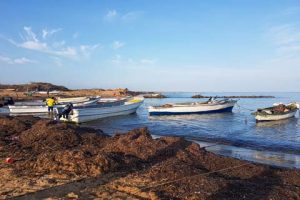
Activities and Tourist Attractions in La Guajira
 Palomino
Palomino
The coastal charm of La Guajira, Palomino, has steadily emerged as a favorite among global travelers. While its rapid transformation brings along both beauty and challenges, it stands as a testament to Colombia’s enduring allure and adaptability.
Overview:
Once a tranquil coastal village, Palomino’s evolution into a vibrant tourist hub echoes that of Taganga. Despite its growing popularity, and the challenges that accompany such growth, Palomino remains a blend of rustic charm and modern comforts. Its seemingly rough façade masks a range of delightful accommodations and activities suitable for all types of travelers.
Palomino’s Beach:
The expansive beach, a dominant feature of Palomino, isn’t just about its vast sandy stretches. While not the best for swimming due to its currents, it serves as a perfect backdrop for relaxation, sunbathing, or just a peaceful stroll along the shoreline. However, the last time I was there, the erosion of the beach was high and it wasn’t a pretty picture.
Tubing on the Palomino River:
An experience not to be missed! Drift along the gentle Palomino river in a tube. However, a word of caution: never underestimate the sun here. Equip yourself with robust sun protection to avoid severe sunburns.
Sierra Nevada Wildlife Viewing:
Dive into the biodiversity of Sierra Nevada. To get the best of this experience, it’s advisable to engage with local guides or tours, often organized through hostels.
Hiking Adventures:
The landscapes around Palomino beckon exploration. However, if you’re considering the Sierra Nevada, proceed with caution. It’s crucial to always have a local guide due to certain areas being monitored for illicit activities.
Beach Horse Riding:
Ever dreamt of galloping along a serene beach? Palomino makes that dream come true. Local hostels and guides can help you book this exhilarating experience.
Alternative Lifestyle in Palomino:
Beyond its natural allure, Palomino has carved a niche in alternative living. Be it a rejuvenating yoga session, mouthwatering vegan dishes, or the freshest seafood – there’s a slice of Palomino for every palate.
 Taironaka:
Taironaka:
Nestled close to Palomino, Taironaka may not technically fall within La Guajira’s boundaries, but its proximity makes it a must-visit for travelers in the region.
Cultural Insights:
Taironaka serves as a window into the indigenous cultures of the Sierra Nevada. Here, visitors can delve deep into the rich heritage, customs, and traditions of the native inhabitants, gaining a profound understanding of their way of life.
The Sonic Surprise of Nature:
One of the standout experiences at Taironaka is the unexpected sonic power of the howling monkey. First-time listeners might be taken aback to learn that this creature’s call can rival the volume of a jet fighter taking off. It’s nature’s own impressive sound show!
Tubing Adventure:
Taironaka also offers an exhilarating tubing experience down its river. A word of caution for those embarking on this adventure: sun protection is paramount. Many, including myself, have underestimated the sun’s intensity here, resulting in severe sunburns and, in some cases, even fever. Always come prepared with adequate sunscreen and reapply as necessary.
 Riohacha: The capital of the Department
Riohacha: The capital of the Department
Situated on the northernmost point of Colombia, Riohacha is the proud capital of La Guajira department. While maintaining its small-town charm, the city bears historical significance and potential for the future.
Historical Overview:
- 1545 – Spanish explorer Nikolaus Federmann first reached the region. This marked the beginning of European contact with the indigenous populations of the region.
- 1846 – The establishment of Riohacha as the administrative center of the region. This move positioned it as a key political and trade hub in the department of La Guajira.
- 1964 – Riohacha was officially declared the capital of La Guajira department after the administrative restructuring of Colombia.
Demographics and Climate:
With a modest population around 150,000, Riohacha offers a more relaxed ambiance compared to Colombia’s larger cities. Its tropical climate sees temperatures touching 40°C on hotter days, though evenings provide a welcome relief.
Beach Promenade and Local Crafts:
Riohacha’s beach promenade is a bustling hub of activity, with indigenous Wayuu vendors displaying their handmade crafts. From colorful bags to unique jewelry, these crafts have become emblematic of the region.
Infrastructure and Future Prospects:
From vantage points like the Hotel Taroa, one can witness the city’s evolving infrastructure, hinting at its vast tourism potential. While accommodation options are currently limited, there’s a noticeable uptick in the gastronomy scene, attracting both locals and tourists alike.
Safety Tips:
Tourists should exercise caution, especially after dark. While the beach promenade is relatively safer during the day and evening, it’s always recommended to use taxis for nighttime commutes.
Transport and Accessibility:
Riohacha’s strategic location makes it an ideal launchpad for exploring the wider region. Its well-connected bus terminal and airport further enhance its accessibility for domestic and international tourists.
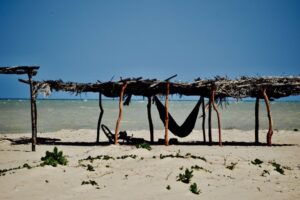
 Uribia: The Wayuu Capital
Uribia: The Wayuu Capital
Nestled amidst vast desert landscapes, Uribia stands out as the cultural heart of the Wayuu people. Its unique location and ambiance offer visitors a blend of cultural immersion and raw natural beauty.
Getting There:
- From Riohacha: Located a 90-minute drive away, Riohacha is the closest major town to Uribia. The road to Uribia is paved, ensuring a smooth journey.
- Colectivos: These shared taxis are the most common way to reach Uribia from Riohacha. Alternatively, one can take a bus to Cuatro Vias, where vehicles await to ferry passengers further.
Local Life and Amenities:
Uribia pulsates with the rhythm of the desert. It serves as a logistics hub, ensuring essential supplies for life in the arid region. The city’s bus terminal, although constructed, remains non-operational as of the last visit. Amidst the dust and heat, Uribia exudes an undeniable charm.
- Cash Transactions: Uribia houses the last ATM for those venturing deeper into the desert. So, ensure you have adequate cash for your onward journey.
- Local Crafts: Uribia is renowned for the world-class hammocks or ‘Chinchorros’ produced here. Prices for these intricately woven hammocks start from COP 250,000 for basic models. Double hammocks, ideal for couples, are priced around COP 500,000. The grand family hammock, often requiring custom orders, starts at 1.5 million.
Humanitarian Perspective:
A visit to Uribia offers more than just sightseeing. The Wayuu in the desert face severe challenges, with poverty and high child mortality rates being major concerns. Visitors are encouraged to purchase essential food and water supplies from Uribia when visiting a Rancheria (Wayuu village). Such contributions act as vital support to these communities.
Travel Tips:
For those looking to explore beyond Uribia without an organized tour, Colectivos are available. These 4×4 pick-ups provide a rustic mode of transport, accommodating both locals and their goods. Although the journey can be dusty and bumpy, it’s an authentic Wayuu experience.
 Cabo de la Vela
Cabo de la Vela
The serene fishing village of Cabo de la Vela, sitting on Colombia’s Caribbean coast, promises an authentic and untouched experience away from urban life’s hustle and bustle.
Essential Amenities:
- Electricity: The village is devoid of a constant electricity supply. In the evenings, generators power the locality, using affordable Venezuelan gasoline. A nearby wind farm exists, but the power lines remain dormant.
- Water: With no running water, the village relies on water tanker trucks for its supply. While some accommodations offer bucket showers, others provide timed showers.
How to Get There:
- From Major Cities: Whether you’re coming from Riohacha or Santa Marta, reaching Cabo de la Vela is straightforward. You can opt for a tour provider or journey via Uribia.
- Travel Tips: For those driving, caution is necessary, especially post-rain, to avoid getting stuck in the sands. The Colectivo, or shared taxi, is another popular option, though be prepared for multiple stops as it serves the local houses en route, extending the travel time.
Stay and Comfort:
- Accommodations: The village offers a range of basic stays. Given the warm climate, many find sleeping in a hammock the most comfortable. However, pack warmly for cooler nights.
Culinary Delights:
- Local Cuisine: The village offers an array of dishes, from chicken, pork, and goat to fresh seafood. However, availability might vary.
- Dining Experience: Patience is a virtue here. With each meal freshly prepared, expect a wait time of over an hour. Familiarity, though, has its perks; regular visitors can pre-order their meals and enjoy a broader selection without the wait.
Adventure Awaits:
- Kitesurfing: Renowned as a kitesurfing haven, Cabo de la Vela shares latitudinal proximity with Aruba. The offshore winds combined with shallow waters create perfect kitesurfing conditions.
- Local Instructors: Kitesurfing schools abound, staffed primarily by young Wayuu instructors. Don’t be startled if you’re paired with a young child; their prowess with the kite is unparalleled. However, a word of caution: Local instructors might occasionally be seen practicing on their own, even during your paid lesson. Stay vigilant and ensure you’re getting the instruction you’ve paid for.
 Pilon de Azucar
Pilon de Azucar
Pilon de Azucar stands as a testament to the breathtaking beauty La Guajira has to offer. Located close to Cabo de la Vela, this hilltop presents visitors with mesmerizing vistas and a serene beach experience.
Getting There:
- From Cabo de la Vela: The most convenient mode of transport from Cabo de la Vela is by moto-taxi. A short ride, lasting around 20 minutes, will take you straight to the base of Pilon de Azucar.
The Climb:
- Accessibility: The ascent to the top of the hill is relatively straightforward, making it accessible to both seasoned hikers and casual walkers alike.
- The Reward: Once you reach the summit, you’ll be greeted with panoramic views of the surrounding area. The expanse of the Caribbean Sea on one side and the sprawling desert landscapes on the other make for an unforgettable sight.
Beach Retreat:
- Pristine Shores: Nestled at the hill’s base is a tranquil beach, characterized by its gentle waves. This beach is less frequented, ensuring a peaceful experience away from the usual tourist crowds.
- A Dip in the Ocean: After the hill climb, there’s nothing more invigorating than diving into the refreshing waters of the Caribbean. The waves are pleasant, providing both relaxation and a dash of fun for swimmers and beachgoers.
 El Faro Lighthouse: A Sunset Spectacle
El Faro Lighthouse: A Sunset Spectacle
El Faro Lighthouse, located in close proximity to Cabo de la Vela, offers one of the most enchanting sunset views in the region. A beacon for many travelers, its elevated position provides sweeping vistas of the Caribbean and the desert, creating a fusion of colors at dusk.
Getting There:
- Walking: For those looking to soak in the scenery and ambiance, a walk to the lighthouse can be both refreshing and invigorating. The path is clear, and the gradual incline offers a moderate trekking experience.
- Moto-taxi: If you’re short on time or prefer a faster mode of transport, hopping on a moto-taxi is a popular choice. Quick and efficient, it’ll get you to the lighthouse in no time.
Sunset Views:
- Panoramic Beauty: The lighthouse’s vantage point ensures an unobstructed view of the horizon. As the sun descends, it paints the sky in hues of oranges, purples, and reds, casting a magical glow over the seascape.
- Photography Haven: For photography enthusiasts, El Faro Lighthouse is a dream. The silhouettes of the lighthouse against the backdrop of a fiery sky make for iconic shots. Don’t forget your camera!
Tips:
- Arrive Early: To get the best spot and to truly immerse yourself in the sunset experience, try to reach a bit before the sun begins its descent.
- Stay Safe: While the area is generally safe, it’s always a good idea to be cautious. If you’re walking back post-sunset, carrying a flashlight might be beneficial.
 Punta Gallinas: A Journey to the Northernmost Point of South America
Punta Gallinas: A Journey to the Northernmost Point of South America
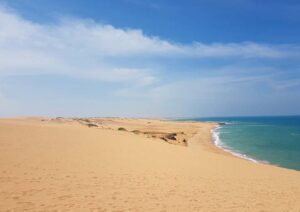
Punta Gallinas is a location that’s not for everyone. While I personally love it, others have described the journey as the worst of their lives. The trip is, without a doubt, an adventure.
To Go Alone or On A Tour?
A frequently asked question is whether to undertake this journey solo or opt for a tour. Personally, I would never venture alone to Punta Gallinas. While I once made the journey by boat and another time by car, both instances were with Wayuu guides. There have been rumors of solo travelers disappearing in this area, so I would strongly advise an organized tour.
The Best of Punta Gallinas:
- El Faro Lighthouse & Hondita Bay: These are standard spots to visit, but for me, the real highlight was the Taroa dunes. The experience of walking down the dune directly into the water is truly spectacular. And if you’re fortunate, you might even spot large flamingo populations during your visit.
Modes of Arrival:
- By Boat: Due to rains rendering the desert impassable on one of my trips, my 70-year-old dad and I took a boat from Cabo de la Vela. Our journey was around 3 hours, but was comfortable because the sea was kind to us. But, be warned, the condition of fishing boats can vary greatly, and if you’re not lucky, the journey can last up to 5 hours on turbulent seas.
- By 4×4: On another trip, despite rains in the previous weeks, we decided to venture by 4×4 cars. We set out from Cabo de la Vela at 5 am in a convoy of three vehicles. There were no roads after an hour into the drive, but the Wayuu are adept at navigating this terrain. We encountered several toll points managed by local Wayuu where we paid in the form of food. The ride was exhilarating, and the landscapes breathtaking. However, challenges such as getting stuck in muddy areas were part of the adventure.
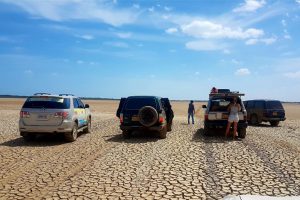
Pro Tips:
- Preparation is Key: If you’re planning to drive, be prepared for the unexpected. On our way back, we had to halt multiple times due to engine issues, and one vehicle even consumed all our water reserves due to a radiator problem.
- Engage with the Locals: Paying tolls in the form of food to the Wayuu is customary. It’s also an opportunity to interact and understand their way of life.
In sum, Punta Gallinas is the embodiment of pure adventure. The challenges faced en route are part and parcel of the experience, making the destination even more rewarding.
 Cerrejon Coal Mine: A Glimpse into the Heart of Colombia’s Mining Industry
Cerrejon Coal Mine: A Glimpse into the Heart of Colombia’s Mining Industry
The Cerrejon coal mine, one of the world’s largest open coal mines, is a marvel of human engineering and a testament to the power of industry. Managed by the heavyweight trio of BHP Billiton, Anglo American, and Glencore, the mine stands as a significant landmark in the Colombian landscape.
The Infrastructure:
The mine boasts an extensive railway line stretching over 150 kilometers to the coast. Three dedicated trains, each equipped with a staggering 109 cars, tirelessly transport the excavated coal to the coastline, awaiting the gargantuan cargo ships.
Exploring the Mine:
Visitors keen on witnessing this industrial marvel up close can do so via organized tours, provided they’ve registered in advance. Once you’re there, the sheer scale of the mine, alongside the colossal machinery in operation, is enough to leave anyone feeling insignificant.
Environmental Concerns & Local Conflicts:
However, Cerrejon’s existence and operations haven’t been without controversies. Over the years, there have been claims of unfulfilled promises made to the local communities, resulting in numerous conflicts. Issues related to decreased river water levels and an inconsistent water supply are also said to be linked to the mine’s activities.
During my tour, the management proudly showcased the renaturalization efforts underway, emphasizing the mine’s commitment to sustainability. Yet, a fellow visitor, a biologist with a Ph.D., pointed out the use of invasive plant species in these renaturalization projects. On probing further, she was quickly labeled an “environmental activist.” This approach – using fast-growing invasive species for quicker ‘greening’ – while efficient, puts the native flora at risk, revealing a possible gap in the mine’s sustainable initiatives.
The Bottom Line:
Cerrejon coal mine is an awe-inspiring spectacle, a symbol of industrial might. Yet, the environmental and social implications of its operations cannot be overlooked. For those planning a visit, it’s an opportunity not just to witness a colossal industrial operation but also to engage in discussions about sustainable mining and its impact on local communities and ecosystems.
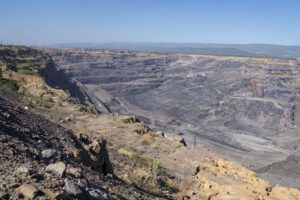
 Los Flamencos Natural Park
Los Flamencos Natural Park
Nestled a short distance away from Riohacha, Los Flamencos Natural Park offers visitors a serene escape into the heart of nature. A mere 30-minute drive from the city, this park is a haven for birdwatchers and nature enthusiasts.
Flora and Fauna:
The park is a sanctuary to a diverse range of local flora and fauna. The varying ecosystems in the park, from the beaches to the mangroves, support a myriad of species, both endemic and migratory. However, the star attraction of Los Flamencos is undoubtedly its namesake – the flamingos.
The Flamingo Show:
Flamingos, with their graceful long necks, slender legs, and vibrant pink feathers, are a sight to behold. These magnificent birds can be seen wading in the park’s waters, filtering food with their specialized beaks. Their synchronized movements and flight patterns are a visual treat. While the sightings of these elegant birds can be seasonal and sometimes sporadic, the chance to witness them in their natural habitat makes the trip worthwhile.
Tips for Visitors:
- Best Time to Visit: Early mornings or late afternoons provide the best lighting for photography and also increase the chances of spotting the flamingos.
- Guided Tours: To enhance the experience, consider opting for a guided tour. Local guides possess a wealth of knowledge about the park’s ecology and can provide insights into the habits and habitats of the various species present.
- Stay Quiet & Respectful: To not disturb the wildlife, visitors are encouraged to move quietly and maintain a respectful distance from the animals.
- Bring Essentials: Equip yourself with binoculars for a closer look, sunscreen to protect from the sun, and plenty of water to stay hydrated.
In conclusion, Los Flamencos Natural Park is more than just a tourist spot; it’s a testament to the beauty and diversity of nature. Whether you’re an avid birdwatcher or just someone looking for a peaceful retreat, the park promises a memorable experience.
 Manaure Salt Flats
Manaure Salt Flats
Located in La Guajira, the salt flats of Manaure are one of Colombia’s primary salt extraction sites. Sprawling across vast landscapes, these flats present a unique spectacle of shimmering white under the blazing sun.
The Extraction Process:
Manaure’s salt flats employ a traditional method of salt extraction. Seawater is channeled into large shallow ponds. Over time, under the intense sun, the water evaporates, leaving behind crystallized salt. This salt is then harvested, processed, and packaged for various uses.
Tourist Experience:
For many visitors, the appeal lies in the sheer visual grandeur of the place. The vast expanses of white, juxtaposed against the blue of the sky, make for stunning photographs. However, as some travelers have pointed out, the tours often lack depth.
- Limited Interaction: Most tours, as described, involve just driving past these flats. The lack of detailed information and limited interaction with the extraction process or the workers can make the visit feel superficial.
- Missed Opportunity: The salt flats, with their centuries-old extraction methods, have a rich history. An in-depth exploration could provide insights into the socio-economic impact of the industry, the science behind salt crystallization, and the daily lives of the workers.
Rancherias: An Insight into Wayuu Culture
In the heart of La Guajira, one of Colombia’s most unique and arid regions, lie the Rancherias—traditional settlements of the indigenous Wayuu people. Venturing into these villages offers a profound look into the cultural and daily life of one of South America’s most resilient indigenous groups.
Wayuu Culture and Lifestyle:
The Wayuu, known for their rich cultural heritage, have a deep connection with their ancestral lands. Their way of life is a testament to their resilience and adaptability to the harsh desert conditions.
- Simplicity and Community: Rancherias are typically composed of several family compounds, each containing a few huts known as ‘piichi’. These huts, made primarily from cactus wood and mud, provide shelter from the intense sun and winds of La Guajira. The layout of these settlements revolves around communal living, with open spaces for gatherings and ceremonies.
- Art and Craftsmanship: The Wayuu are renowned for their intricate weaving skills, producing vibrant bags known as ‘mochilas’ and the world-famous ‘Chinchorros’ hammocks. Every design tells a story, often inspired by nature or Wayuu mythology. These items, apart from being essential household items, have become significant sources of income for the Wayuu, as they’re sought after both locally and internationally.
Visiting Rancherias:
When planning a visit to the Rancherias:
- Respect and Sensitivity: The Wayuu, like all indigenous groups, deserve respect for their traditions and way of life. Visitors should approach with an open mind, ready to learn and observe without imposing.
- Trade and Support: As suggested, bringing food can be a kind gesture given the region’s harsh conditions. Purchasing their crafts not only supports their livelihood but also promotes the continuation of their rich weaving traditions. When buying, remember that each item represents hours of meticulous work, so offering a fair price is essential.
- Guided Visits: To ensure a genuine and respectful experience, it’s recommended to visit with a local guide or through an organized tour. They can provide valuable insights into Wayuu culture, traditions, and etiquette.
Prices in La Guajira
La Guajira offers a unique blend of desert landscapes, Caribbean coastline, and indigenous culture, all without burning a hole in your pocket. If you’re planning a trip here, it’s essential to have an idea of the general costs, so you can budget accordingly.
General Pricing Overview:
La Guajira is relatively affordable when compared to other tourist hotspots in Colombia. The prices reflect the region’s laid-back vibe and straightforward way of life. Nonetheless, always inquire about the cost in advance to avoid any surprises. Bargaining is not just acceptable; it’s a part of the culture throughout Colombia.
Here’s a rough guide to some common expenses:
- Food: Expect to pay between 20,000 to 40,000 pesos for a meal. Seafood, given its abundance, is often a popular and affordable choice. Prices may vary based on the location and the type of establishment.
- Kitesurfing: A popular activity in Cabo de la Vela, one hour of kiting can cost upwards of 100,000 pesos. This might include equipment rental and, in some cases, an instructor.
- Moto-taxi to Pilon de Azucar: A quick and convenient way to reach Pilon de Azucar from Cabo de la Vela. Rates typically range between 15,000 to 20,000 pesos.
- Collectivo from Uribia to Cabo de la Vela: These are shared rides and usually cost around 25,000 pesos. It’s a bumpy but authentic way to travel across the desert landscape.
- Sleeping in a Chinchorro (hammock): A quintessential La Guajira experience, spending a night in a hammock can cost around 30,000 pesos. It’s a unique way to embrace the local culture and sleep under the stars.
Tips:
- Negotiate: While prices are generally reasonable, there’s no harm in trying to get a better deal, especially if you’re purchasing goods or services in bulk.
- Carry Cash: ATMs might be scarce, especially as you move deeper into La Guajira. Ensure you have enough cash, especially for remote areas.
Recommended accommodations in La Guajira
Conclude your trip in La Guajira with a memorable stay. In Riohacha or Cabo de la Vela the most charming accommodations are waiting for you.
For more information visit our recommendations of lodgings in La Guajira.
Nightlife
Nightlife in La Guajira is tranquil and understated, reflecting the laid-back pace of life in this scenic region.
Cultural Agenda in La Guajira
- Dividivi Festival:
- When: June-July
- Description: The Dividivi Festival celebrates the region’s culture, history, and traditions. Named after the Dividivi tree, which is native to the region, this festival features local music, dances, and gastronomic delights.
- Festival of the Wayuu Culture (Uribia):
- When: May
- Description: A celebration dedicated to the indigenous Wayuu people. It showcases their rich heritage, traditions, handicrafts, dances, and music. A vibrant event that offers a deep dive into the Wayuu way of life.
- Cuna de Acordeones Festival (Villanueva):
- When: September
- Description: Translated as the “Cradle of Accordions Festival,” this event celebrates the region’s musical heritage, particularly the importance of the accordion in vallenato music. Expect electrifying performances, competitions, and a festive atmosphere.
- Festival of the Coal (Barrancas):
- When: October
- Description: A unique festival that sheds light on the significance of coal mining in the region. Through various activities and exhibitions, the event highlights both the industrial and cultural importance of coal.
- Francisco el Hombre Festival (Riohacha):
- When: January
- Description: Named after the legendary figure in vallenato folklore, this festival is a musical competition where artists vie for the title of best vallenato performer. A must-visit for music enthusiasts and those keen to understand the region’s sonic heritage.
Shopping in La Guajira
La Guajira is renowned for its unique and vibrant handicrafts, deeply rooted in the indigenous Wayuu culture. Here’s a brief guide to shopping in this region:
- Wayuu Bags (Mochilas Wayuu):
- Description: These are intricately woven bags showcasing vibrant patterns and colors. Each bag is a testament to the craftsmanship of the Wayuu women and can take up to a month to create.
- Where to Buy: Directly from the Wayuu artisans or in local markets. It ensures that the proceeds go directly to the craftsmen and craftswomen, supporting their livelihood.
- Hammocks (Chinchorros):
- Description: Known for their superior quality and detailed designs, Wayuu hammocks are not only comfortable but also aesthetically pleasing. They often feature geometric patterns and a range of colors.
- Where to Buy: Purchase directly from the Wayuu communities or at artisan markets in the region.
- Wayuu Hats:
- Description: Handwoven hats that are perfect for the sunny weather of La Guajira. They come in various designs and colors, offering protection and style.
- Where to Buy: Directly from Wayuu artisans or local craft markets.
- Beaded Jewelry:
- Description: The Wayuu people create vibrant beaded necklaces, bracelets, and earrings. Each piece tells a story and represents the cultural heritage of the Wayuu.
- Where to Buy: Directly from the artisans or in local markets.
Tips for Shopping in La Guajira:
- Direct Purchase: Buying directly from the Wayuu ensures authenticity and helps in supporting the local community.
- Bargaining: While it’s customary to haggle, do so respectfully. Remember that these crafts take time and skill to produce.
- Authenticity: Be cautious of imitation products. Genuine Wayuu products are handwoven and often come with a higher price tag due to the craftsmanship involved.
By shopping directly with the producing Wayuu, you not only get an authentic product but also contribute to the preservation and growth of the Wayuu culture and traditions.
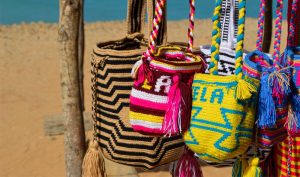
Food in La Guajira
La Guajira, a stunning peninsula on the northernmost tip of Colombia, offers a unique blend of coastal and desert landscapes. This diversity is mirrored in its culinary offerings. Here’s a brief overview of the food you can savor in La Guajira:
- Seafood:
- Description: Given its proximity to the Caribbean coast, seafood is a staple in La Guajira. Fresh catches like fish, shrimp, crab, and lobster are commonly served.
- Dishes to Try: Cazuela de Mariscos (seafood stew), Pescado Frito (fried fish), and Arroz con Camarones (rice with shrimp).
- Goat:
- Description: Goat meat, known locally as chivo, is a regional specialty. While it might not be to everyone’s taste due to its distinct flavor, it’s a must-try for those looking to experience authentic Guajiran cuisine.
- Dishes to Try: Chivo a la Llanera (grilled goat) and Friche (a dish made with goat organs).
- Arepa de Huevo:
- Description: A type of cornmeal cake filled with an egg and then fried. It’s a popular breakfast item and snack throughout the region.
- Serving: Often paired with cheese or eaten on its own.
- Bollos:
- Description: Steamed corn dough, often filled with cheese or other fillings.
- Varieties: Bollo de Yuca, made with cassava, and Bollo Limpio, made with corn.
- Bebidas (Drinks):
- Popular Choices: Fresh coconut water directly from the coconuts, aguapanela (a sweet drink made from sugar cane), and chicha, a traditional fermented drink.
Best travel time
La Guajira, a unique blend of desert landscapes and coastal beauty, offers distinct experiences throughout the year. Whether you’re into kite surfing, cultural events, or nature watching, timing your visit right can enhance your experience.
- General Climate:
- La Guajira boasts a tropical desert climate. It’s predominantly hot and dry, with temperatures frequently surpassing 30°C (86°F).
- Hurricane Season and Rainy Period:
- The hurricane season, which usually spans from June to November, brings with it the highest risk of rainfall in La Guajira. During this period, the region can experience heavy rainfalls, potentially causing flash floods or rendering some roads impassable.
- Despite the challenges, this season paints the desert in lush green hues, providing a contrast to its usual stark beauty.
- Dry Season:
- Running from December to May, the dry season witnesses minimal rainfall. This period is popular among tourists for its classic desert landscape characterized by vast sand dunes and sparse vegetation.
- Kite Surfing in Cabo de la Vela:
- For those keen on kite surfing, December to April is the prime window, offering consistent winds ideal for the sport. It’s advisable to consult a wind table or local kite surfing outfits for precise conditions.
Transport Systems
Navigating through the unique landscapes of La Guajira requires a mix of conventional and unconventional modes of transportation. Given its topography and regional infrastructure, here’s a breakdown of the transport systems in the department:
- Inter-Departmental Buses:
- Direct Services: There are direct bus services connecting La Guajira to major cities like Santa Marta and Cartagena. These buses are reliable, often air-conditioned, and equipped with comfortable seating.
- Connectivity with Neighboring Regions: Besides the coastal cities, La Guajira also has bus connections to the neighboring department of Cesar and the country of Venezuela. This means travelers can access almost any national destination from La Guajira by bus.
- Local Transport within La Guajira:
- Local Buses: While these are available, their frequency and routes might be limited given the region’s vast desert landscapes and dispersed settlements.
- 4×4 Collectives: Given the terrain, especially when heading towards destinations like Punta Gallinas or Cabo de La Vela, 4×4 collectives are a popular choice. These vehicles are equipped to handle the challenging desert roads and provide a rugged, adventurous experience.
- Shared Taxis: These operate within towns and can be a quicker alternative to local buses. They usually run on fixed routes and pick up passengers along the way.
- Travel Tip for Long Journeys:
- If you’re planning to journey from Cabo de La Vela to Cartagena in a single day, it’s a long ride, and you’d need to start your day early. This ensures you have buffer time for any unforeseen delays and still reach your destination before nightfall.
My Likes and Dislikes About La Guajira: A Personal Perspective
La Guajira holds a special place in my heart, a raw blend of natural beauty and cultural depth that makes it a unique travel destination. Here’s a breakdown of what resonated with me and what felt like a chink in its majestic armor:
What I Loved About La Guajira:
- The Magical Landscape: Words might fall short to describe the captivating vistas of La Guajira. The sprawling desert meeting the deep blue sea paints a surreal picture, a dreamlike palette that stays with you long after you’ve left.
- The Gastronomic Delight: The local cuisine, a delicious amalgamation of seafood and traditional dishes, was a treat. The freshness of the ingredients and the distinct flavors made every meal a memorable one.
- Rich Cultural Tapestry: The Wayuu culture, its traditions, and crafts provided a deep insight into the region’s rich heritage. Interacting with the local community and learning about their ways was enlightening.
- Adventurous Spirit: The array of activities, from kite surfing to exploring off-beat paths, made it an adventurer’s haven. The challenges posed by the landscape only added to the thrill.
- The Climate: While La Guajira boasts of soaring temperatures, the aridness of the climate made it manageable for me. The dryness meant that even during the hottest times, the lack of humidity made it bearable.
The Aspects That Concerned Me:
- Socio-Economic Challenges: It was disheartening to witness the stark contrast between the natural beauty of La Guajira and the evident socio-economic struggles of its people. High infant mortality rates and low education levels pointed towards deeper systemic issues that the region grapples with.
- Corruption and Governance: Hearing about La Guajira being one of Colombia’s most corrupt departments was troubling. This, coupled with the lack of basic amenities and infrastructure, made me reflect on the disparities that exist.
- Security Concerns: The ongoing situation in neighboring Venezuela and its ripple effects on La Guajira’s security was a constant concern. While I didn’t face any direct issues, the overarching tension was palpable.
Colombia Travel Guides
Here you will find travel guides for the most popular regions in Colombia, which we have put together during our extensive travels around the country.
- Colombia Travel Guide
- Bogota Colombia Travel Guide
- Medellin Colombia Travel Guide
- Cartagena Colombia Travel Guide
- Santa Marta Colombia Travel Guide
- Cali Colombia Travel Guide
- Coffee Triangle Colombia Travel Guide
- Barranquilla Colombia Travel Guide
- La Guajira Colombia Travel Guide
- Tayrona Park Colombia Travel Guide
- Palomino Colombia Travel Guide
- San Andres Island Colombia Travel Guide
- Providencia Island Colombia Travel Guide
- Casanare Llanos Colombia Travel Guide
- Amazonas Colombia Travel Guide
- Chocó Colombia Travel Guide
- Santander Colombia Travel Guide
- Boyaca Colombia Travel Guide
Travel Guides to Colombia’s Small Towns
Here you will find travel guides for less popular destinations in Colombia. Some of these destinations are even real insider tips and not even known to the Colombians as travel destinations.
- Aguachica Colombia Travel Guide
- Arauca Colombia Travel Guide
- Armenia Colombia Travel Guide
- Barrancabermeja Colombia Travel Guide
- Bucaramanga Colombia Travel Guide
- Buenaventura Colombia Travel Guide
- Canyon Chicamocha Colombia Travel Guide
- El Carmen de Bolivar Colombia Travel Guide
- Caucasia Colombia Travel Guide
- Cucuta Colombia Travel Guide
- Florencia Colombia Travel Guide
- Ibagué Colombia Travel Guide
- Inirida Colombia Travel Guide
- Ipiales Colombia Travel Guide
- Magangue Colombia Travel Guide
- Manizales Colombia Travel Guide
- Mitu Colombia Travel Guide
- Mocoa Colombia Travel Guide
- Monteria Colombia Travel Guide
- Neiva Colombia Travel Guide
- Palmira Colombia Travel Guide
- Pasto Colombia Travel Guide
- Pereira Colombia Travel Guide
- Popayan Colombia Travel Guide
- Puerto Asis Colombia Travel Guide
- Puerto Carreno Colombia Travel Guide
- Quibdo Colombia Travel Guide
- Riohacha Colombia Travel Guide
- San José del Guaviare Colombia Travel Guide
- Sincelejo Colombia Travel Guide
- Sogamoso Colombia Travel Guide
- Tulua Colombia Travel Guide
- Tumaco Colombia Travel Guide
- Tunja Colombia Travel Guide
- Turbo Colombia Travel Guide
- Valledupar Colombia Travel Guide
- Villa de Leyva Colombia Travel Guide
- Villavicencio Colombia Travel Guide
- Yopal Colombia Travel Guide

